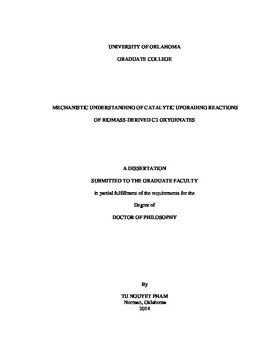| dc.description.abstract | Lignocellulosic biomass, being the promising renewable source of carbon, has a great potential to serve as a sustainable platform for the production of fuels and chemicals. The conversion of lignocellulose to fuels and chemicals requires the effective utilization of small light oxygenates, in particular, C2 as the major compounds derived from hemicellulose portion. In this study, catalytic processes for the conversion of biomass to fuels and chemicals were developed and investigated through two important C2 platform molecules, acetic acid and ethanol.
In the first part, catalytic processing of acetic acid as a common product formed in biomass pyrolysis was studied. Ketonization is an ideal reaction for upgrading of this compound as it removes acidity and oxygen as well as creates C-C bonds that enlarge carbon backbones and maximize carbon yields in the fuel range. In this study, we have developed a new catalyst, Ru/TiO2 that shows high activity and selectivity for ketonization of acetic acid in both vapor and liquid (organic and aqueous) phase. A rigorous kinetics study using carboxylic acids of varying carbon chain length, i.e., acetic, propionic, and butyric acid have been conducted over this catalyst. A thorough analysis built upon a Langmuir Hinshelwood (LH) model and transition state theory (TST) shows that the reaction follows a second-order expression with respect to carboxylic acids. The heat of adsorption was found very similar for the three acids, in spite of their different chain lengths, and significantly higher than those of the ketonization products, i.e. ketone, water and CO2. The change in adsorption entropy of the acids (in absolute value) with respect to the gas phase was found to decrease with increasing chain length. These results are consistent with a strongly adsorbed bidentate configuration, in which the main interaction with the surface is via the carboxylic group while the alkyl group moves rather freely. Activation energy derived from the LH model as well as activation enthalpy and entropy derived from TST provided insight into the reaction intermediates. Both of the latter two parameters were found to increase with increasing carbon chain length of the acids. This compensation effect can be interpreted in terms of the nature of the transition state. It is concluded that ketonization proceeds through a β-ketoacid intermediate with an early transition state, in which the C-C bond forms.
In the second part, catalytic conversion of bio-ethanol as an economically attractive feedstock to a valuable chemical, i.e. 1,3-butadiene, was investigated. This study provides a method to optimize the key intermediate step in butadiene production process from ethanol, which is the conversion of acetaldehyde and ethanol to crotonaldehyde and crotyl alcohol. This process requires an appropriate balance of acid and basic sites on the catalyst surface to maximize the yields of the crotonaldehyde and crotyl alcohol. By tailoring the molar ratio of the MgO and B2O3 during catalyst preparation through a combustion method, we developed a new B-MgO material, which has excellent catalytic properties with high selectivity of up to 75% for crotonaldehyde and crotyl alcohol. A thorough characterization of the catalysts suggests that the incorporation of Boron into MgO structure during the synthesis effectively modifies the properties and structure of MgO, creating well-balanced Lewis acid and basic sites and enhancing the catalytic performance. | en_US |
